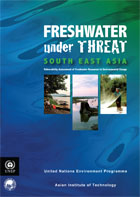
Bangkok, 21 May 2009
- A new report by the UN EnvironmentProgramme and the Asian Institute of Technology (AIT), Freshwater under
Threat – South East Asia, has found that countries in South East Asia
should act now to secure the region’s abundant water supplies into the
future.
The study focuses on the Mekong River Basin - the region’s most
important water source, which stretches across China, Myanmar, Lao PDR,
Thailand, Cambodia, and Viet Nam. Ranked among the world’s great
rivers, the per capita water resources in the Mekong compares with the
world average of 6,860 m3/person/year.
However, rapid development, climate change, and management concerns
will significantly affect the Basin’s water resources and its
inhabitants in the years ahead, according to the report.
“The time to tackle these challenges is now, otherwise the projected
growth and development may impact on the basin’s ability to meet future
water needs,” said Young-Woo Park, UNEP’s Regional Director and
Representative.
The study found that the Mekong River Basin is moderately vulnerable
to environmental change, with a Vulnerability Index of 0.31. This
indicates that the Basin is in good condition in terms of water
availability, but has management challenges, especially with respect to
transboundary issues and use of its waters.
“Considering the very high economic growth rates in parts of the
Basin, and the consequent need to harness its water resources, the
ongoing cooperation between the co-riparian countries should be
strengthened. This will ensure that cross-border differences over water
and its use is minimised in the years ahead,” said Young-Woo Park.
Population growth and increasing urbanization is also expected to
increase demand for water in the years ahead. Warming temperatures and
their impacts on sea-level rise and the glaciers of the Tibetan
Plateau, the source of the Mekong, are also expected to compound these
pressures.
“The Tibetan Plateau has been identified as a climate system that is
likely to change rapidly because of global warming. There might be less
rainfall in some parts of the basin and thus less flooding.
Furthermore, a modest 20 cm rise in sea levels would see salt waters
going 60 – 70 km upstream during the dry season, affecting water and
land along the riverbanks. The impacts of climate change could be
devastating for the millions of people who depend on the Mekong for
their livelihoods,” said Dr Mukand Babel of AIT.
Water productivity is also low. At present, the GDP produced from one
cubic metre of water used in the Mekong River Basin is US$2.4, much
lower than the average US$23.8 of the world’s top five food producers
(China, Brazil, United States, Mexico and France).
The report identifies four areas that need to be addressed:
1. River Basin Management – The on-going cooperation
between Mekong River Basin countries needs to be strengthened to ensure
transboundary issues related to water are minimised in the years ahead.
This should include reaching a consensus on equitable water sharing
between co-riparian countries.
2. Climate Change – The Mekong River Basin countries
have a significant stake in combating climate change. Research suggests
that global warming will impact heavily on the Tibetan Plateau. If this
occurs it would lead to a dramatic decrease in the runoff volumes in
parts of the Basin;
3. Water Productivity – More technical support and
education is needed to increase the productivity of water use in the
region.
4. Safe Drinking Water – Access to safe drinking
water in the Mekong River Basin is lower than the world average of 83
per cent. However, access to improved sanitation facilities in the
Mekong River Basin compares with the corresponding world average of 59
per cent.
This report is a product of collaborative efforts between the UN
Environment Programme and the Asian Institute of Technology (AIT). It
follows the release of Freshwater Under Threat - South Asia and
Freshwater Under Threat – Northeast Asia.
Related articles can be seen as follows:
http://www.chinadialogue.net/blog/show/single/en/3030
http://wtop.com/?nid=105&sid=1680213
http://www.examiner.com/a-2027212~UN_study_advises_caution_over_dams.html
http://www.kansascity.com/439/story/1209128.html
http://www.guardian.co.uk/world/feedarticle/8518692
http://nongsain.indopia.in/India-usa-uk
news/print_news.php?id=579509&head=Technology
http://www.pr-inside.com/un-study-advises-caution-over-dams-r1268614.htm
http://news.aol.com/article/un-study-advises-caution-over-dams/493204
http://www.euronews24.org/technology/un-study-advises-caution-over-dams/
http://www.globalgoodnews.com/government-news-a.html?art=12429094639156242
http://nongsain.indopia.in/India-usa-uk-news/latest-news/579509/Technology/8/20/I
http://goldsea.com/Text/index.php?id=468
http://dailyme.com/story/2009052100001893/study-advises-caution-dams.html
http://www.chinadialogue.net/blog/show/single/en/3030
http://www.indopia.in/India-usa-uk-news/latest-news/579514/International/2/1/2
http://www.roap.unep.org/press/NR09-07.html
A related story:
http://www.ait.asia/news-and-events/2009/hundreds-of-millions-in-south-asia-face-water-security-threat-unep2013ait-report-warns/
For More Information:
Satwant Kaur, Regional Information Officer, UNEP Regional Office for
Asia and the Pacific, E-mail: kaur@un.org,
Tel: +662 2882127,
Mobile: +6683 9086000
The report can be found at: www.roap.unep.org
